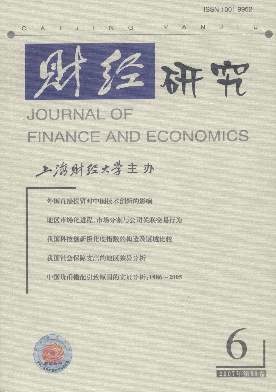人力资本门槛、创新互动能力与低发展陷阱——对1990年以来中国地区经济差距的实证检验
财经研究 2007 年 第 33 卷第 06 期, 页码:78 - 90
摘要
参考文献
摘要
1990年以来,中国各地区经济差距不断扩大现象引起理论界的广泛关注。内生增长理论认为,原因可能在于落后地区的低人力资本禀赋难以同本地创新形成良性互动,导致经济增长速度始终囿于低发展陷阱。中国地区数据的实证结果表明,中等层次人力资本是创新经济增长的主要驱动要素,同一人力资本门槛内部的相近地区经济增长率基本保持均衡。如果外生政策变量不诱导落后地区跨越人力资本门槛,这类地区的低发展均衡状态将很难被突破。因此,在增加物质资本投入的同时突出人力资本建设,对平衡中国各地区经济增长具有很强的政策意义。
[1]蔡?,都阳.中国地区经济增长的趋同与差异[J].经济研究,2000,(10):30~37.
[2]林毅夫,刘培林.中国的经济发展战略与地区收入差距[J].经济研究,2003,(3):19~25.
[3]刘厚俊,刘正良.人力资本门槛与FDI效应吸收[J].经济科学,2006,(5):90~98.
[4]马拴友,于红霞.转移支付与地区经济收敛[J].经济研究2003,(3):26~33.
[5]王小鲁,樊纲.中国地区差距的变动趋势和影响因素[J].经济研究,2004,(1):33~44.
[6]沈坤荣,马俊.中国经济增长的“俱乐部收敛”特征及其成因研究[J].经济研究,2002,(1):33~39.
[7]Acemoglu.Searchin the labour market,incomplete contracts and growth[R].CEPRDiscussion Paper,No.1026,1994.
[8]Aghion,Bloom,Blundell.Competition and innovation:Aninverted-u relationship[J].Quarterly Journal of Economics,2005,120(2):701~728.
[9]Agion,Howitt.A model of growth through creative destruction[J].Econometrica,1992,60(2):323~351.
[10]Azariadis,Drazen.Threshold externalities in economic development.Quarterly Jour-nal of Economics,1990,105(2):501~556.
[11]Barro,Sala-I-Martin.Economic Growth[M].New York:McGraw-Hill,1995.
[12]Bresnahan T.Measuring the spillovers fromtechnical advance:Mainframe computersin financial services[J].American Economic Review,1986,76(4):742~755.
[13]Grossman,Helpman.Innovation and growth in the global economy[M].CambridgeMA.MIT Press,1991.
[14]Grossman,Helpman.Endogenous innovation in the theory of growth[J].Journal ofEconomic Perspective,1994,8(1):23~44.
[15]Lucas R E.On the mechanics of economic development[J].Journal of Monetary Eco-nomics,1988,22(1):3~42.
[16]Redding.The low-skill,low-quality trap:Strategic complementarities between humancapital and R&D[J].The Economic Journal,1996,106:458~470.
[17]Young A.Invention and bounded learning by doing[J].Journal of Political Economy,1993,101(3):443~472.
[2]林毅夫,刘培林.中国的经济发展战略与地区收入差距[J].经济研究,2003,(3):19~25.
[3]刘厚俊,刘正良.人力资本门槛与FDI效应吸收[J].经济科学,2006,(5):90~98.
[4]马拴友,于红霞.转移支付与地区经济收敛[J].经济研究2003,(3):26~33.
[5]王小鲁,樊纲.中国地区差距的变动趋势和影响因素[J].经济研究,2004,(1):33~44.
[6]沈坤荣,马俊.中国经济增长的“俱乐部收敛”特征及其成因研究[J].经济研究,2002,(1):33~39.
[7]Acemoglu.Searchin the labour market,incomplete contracts and growth[R].CEPRDiscussion Paper,No.1026,1994.
[8]Aghion,Bloom,Blundell.Competition and innovation:Aninverted-u relationship[J].Quarterly Journal of Economics,2005,120(2):701~728.
[9]Agion,Howitt.A model of growth through creative destruction[J].Econometrica,1992,60(2):323~351.
[10]Azariadis,Drazen.Threshold externalities in economic development.Quarterly Jour-nal of Economics,1990,105(2):501~556.
[11]Barro,Sala-I-Martin.Economic Growth[M].New York:McGraw-Hill,1995.
[12]Bresnahan T.Measuring the spillovers fromtechnical advance:Mainframe computersin financial services[J].American Economic Review,1986,76(4):742~755.
[13]Grossman,Helpman.Innovation and growth in the global economy[M].CambridgeMA.MIT Press,1991.
[14]Grossman,Helpman.Endogenous innovation in the theory of growth[J].Journal ofEconomic Perspective,1994,8(1):23~44.
[15]Lucas R E.On the mechanics of economic development[J].Journal of Monetary Eco-nomics,1988,22(1):3~42.
[16]Redding.The low-skill,low-quality trap:Strategic complementarities between humancapital and R&D[J].The Economic Journal,1996,106:458~470.
[17]Young A.Invention and bounded learning by doing[J].Journal of Political Economy,1993,101(3):443~472.
引用本文
郭玉清, 杨栋. 人力资本门槛、创新互动能力与低发展陷阱——对1990年以来中国地区经济差距的实证检验[J]. 财经研究, 2007, 33(6): 78–90.
导出参考文献,格式为:
下一篇:我国社会保障支出的地区差异分析





 6131
6131  730
730

